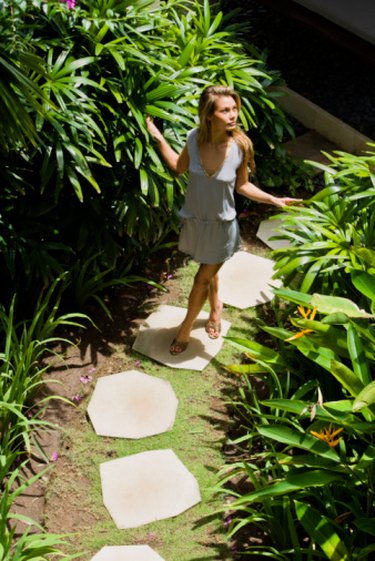Things You'll Need
Large bag of ready-mix cement or mortar mix
1 five-gallon bucket
Water
Liquid measuring cup
1 can of vegetable oil spray or tub of petroleum jelly
Large mold(s) or large plastic flower pot, water-catching tray or large plastic bin lid
Craft stick
Optional:
Decorative stones, beads, glass or ceramic pieces and tiles

Decorative stepping stones are expensive to purchase and even kits to make them are costly. Using found objects or molds, along with your own mortar or cement mixture cuts costs considerably. Home supply stores stock the powdered material used to make cement, and a five- or six-pound bag will make several large stepping stones. Once you have the confidence in knowing all the steps to complete the project, you'll be able to create your own pathways to invite friends to your door.
Step 1
Spray vegetable oil to coat the interior of the stepping stone mold, or apply petroleum jelly in a thin layer. This allows the cement to release from the mold after it is dry. Disposable molds are simply peeled off the dried cement in pieces, without the need for oils.
Video of the Day
Step 2
Place decorative materials on the bottom of the mold, if this is to become the surface of the stepping stone. Cut a piece of contact vinyl adhesive to fit. Place it sticky-side-up inside the mold. Set the decorations upside-down on that. This prevents disturbing them when the cement or mortar is spooned in. The decorations appear on the surface when the stone is removed from the mold. Apply decorations onto the surface while the cement is still drying, but after it has set-up well. If the decorations are applied too soon, they will sink into the cement. If the decorations do sink into the cement, retrieve, rinse and dry them before reapplying.
Step 3
Mix the cement or mortar in the five gallon bucket, as directed on the bag. Use a measuring cup to get the amounts correct. One part mix to 4 parts water is the standard recipe if there are no instructions given. Add more water if the mix is too thick. Create a consistency of thick brownie batter. Stir well to be sure all the material is wet and there are no remaining lumps of dry mix.
Step 4
Distribute the mixture into the mold carefully, one spoonful at a time. Avoid pouring it in since this creates air bubbles, which cause cracking after the cement dries. Add the mixture until the cement is approximately two inches thick; it will shrink slightly as it dries. Tap the sides of the mold to remove air pockets when it is full. If possible, pick up the filled mold an inch or two and drop it onto a level surface a few times to help remove any remaining air pockets. Smooth the top of the mold using a craft stick. Avoid moving the mold at this point; cracking has been noted to occur when molds are moved during the setting-up process.
Step 5
Allow the mixture to dry before attempting to remove the material from the mold. This will take at least 36 hours, depending on the thickness of the mixture and the type of material used to make the cement. Follow the directions on the bag of mix you are using. The dried stepping stone will come out when the mold is turned over. Tap the bottom of the mold with a mallet if the material does not release readily. If necessary, use an old butter knife to pry the mold off the cement.
Tip
Read labels when purchasing cement to be sure you obtain the look you want for your stepping stones; some mixes have large pebbles in them.
Protect surfaces if working indoors and provide adequate ventilation when mixing the cement.
An acrylic sealer is recommended to give the finished surface lasting appeal and water resistance.
Certain materials will fade in continual sunlight, so keep that in mind when choosing decorative elements.
Warning
Wear eye protection and gloves when mixing and using cement or mortar.
Wear old clothes when working with cement.
Video of the Day